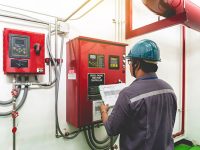Demolition work is a high-risk undertaking, and making sure it’s carried out as safely as possible is critical to protect everyone involved in the process.
Demolition calls for meticulous planning, detailed risk evaluation to identify potential hazards, and rigorous control measures to eliminate or minimise dangers.
Demolition work is also subject to a raft of legal health and safety and licensing requirements you need to be aware of.
In this post, we’ll be looking at the most effective ways to manage safety hazards in demolition operations. First, though, we’ll deal with a question that industry outsiders often ask…
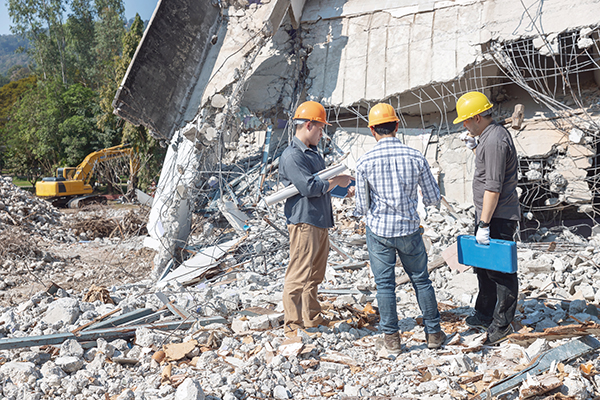
What is Demolition Work?
Demolition refers to knocking down or taking apart anything that’s key to structural integrity of constructions such as buildings, towers and chimney stacks.
It’s classed as high-risk construction work but does not include:
-
Dismantling formwork or scaffolding.
-
Removal of telecommunication, lighting or power poles.
Assessing Risks of Demolition Work
Risk assessment is essential to manage safety hazards in demolition work. Common risks include:
-
Electricity supplies still live.
-
Danger of unforeseen structure collapse.
-
Falls from height.
-
Falling objects.
-
Encountering underground utility lines.
-
Inhalation of airborne contaminants such as asbestos fibres.
Identifying Hazards
You can identify potential safety hazards by:
-
Inspecting the site – ideally with a professional health and safety advisor.
-
Consulting workers on any known risks.
-
Checking records of previous injuries in similar jobs.
-
Consulting with other specialist contractors working on the site.
Planning Ahead
Planning ahead to ensure demolition work with no accidents or injuries includes:
-
Getting an engineering survey on the condition of the structure and any possibility of unplanned collapse.
-
Locating nearby utilities so they can be secured or moved.
-
Drawing up an evacuation plan in the event of fire.
-
Having first-aid facilities in place.
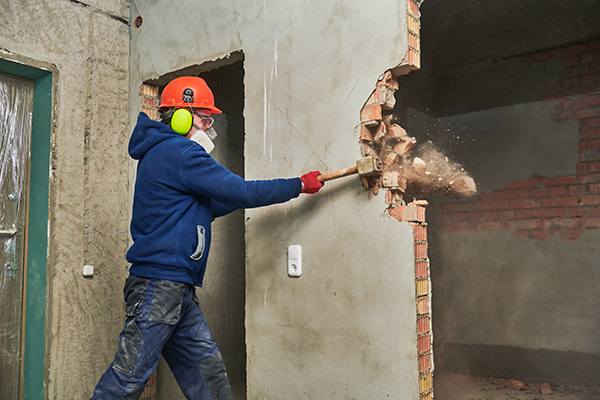
Protection Equipment
Before starting demolition operations, you need to make sure your workers have any necessary personal protective equipment (PPE). This may include protective clothing or apparatus for respiratory protection.
PPE can also avoid damage to:
-
Eyesight.
-
Hearing.
-
Hands and feet.
Workers should also be trained on PPE use and maintenance.
Furthermore, you may need to have a personal fall arrest systems (PFAS) in place.
Controlling Demolition Hazards
Demolition risks can be eliminated by eliminating hazards – for instance, doing work at ground level to avoid working at height or the use of cranes.
Although the ideal, elimination of hazards is not always possible. In these cases, you need to minimise risks with a set of control measures such as use of:
-
Mechanical demolition instead of manual, if possible.
-
Barriers to isolate hazards and prevent accidents.
-
Protective structures to minimise the risk from falling objects.
-
Warning signs, especially in areas of particular high risk.
-
Hard hats, steel-cap boots and high-visibility vests for workers.
In most cases, a combination of control measures like these is the best way to minimise risk to the lowest level possible.
Reviewing and Maintaining Control Measures
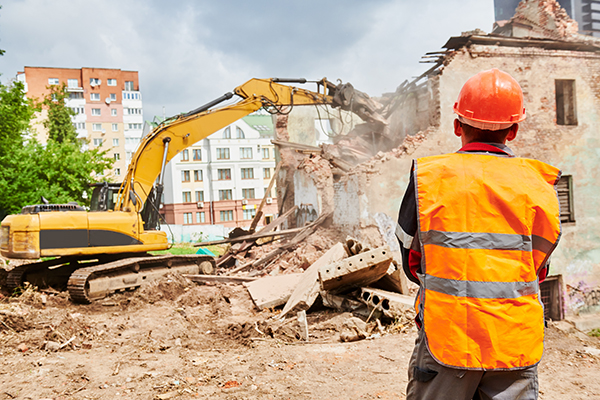 Managing demolition safety hazards requires regularly reviewing control measures to ensure they remain effective –
Managing demolition safety hazards requires regularly reviewing control measures to ensure they remain effective –
-
Fit for purpose.
-
Applicable to the nature and duration of the work.
-
Set up and used correctly
If your demolition risk control measures change working practices, you should consult workers to develop safe procedures, and provide them with training on the changes.
You also need to make sure your control measures don’t create new hazards. Workers are often able to quickly identify new problems when they occur and recommend solutions.
Demolition Regulations
Safety regulations governing demolition aren’t an option; they’re a legal requirement. If you own or run any type business, you must comply with workplace health and safety (WHS) laws.
Formerly known as occupational health and safety (OHS), WHS entails risk management to protect everyone in a work space, including demolition and construction sites. The laws apply to visitors, customers, and suppliers, as well as anyone doing work for you.
Specific regulations include:
Notice of Demolition
You must give written notice to the regulator if you’re going to do any of the following:
-
Demolition or partial demolition of structures six metres high or more that are loadbearing or otherwise critical to structural integrity.
-
Demolition work involving load-moving machinery on a suspended floor.
-
Use explosives.
Safe Work Method Statements
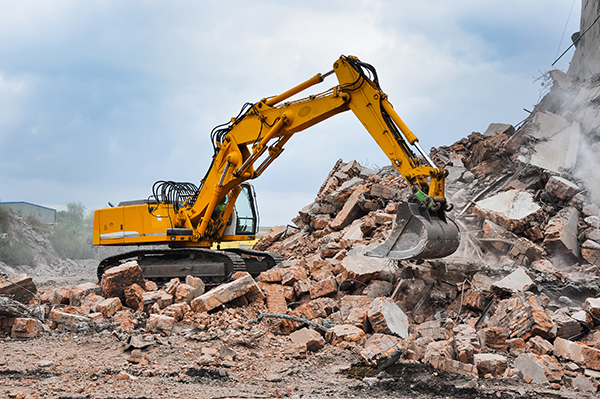 A Safe Work Method Statement (SWMS) is needed for demolition work to help ensure it’s carried out safely. The statement must include such things as:
A Safe Work Method Statement (SWMS) is needed for demolition work to help ensure it’s carried out safely. The statement must include such things as:
-
Type of demolition work.
-
How health and safety risks will be managed.
-
How control measures will be implemented, monitored and reviewed.
Demolition Licences
A licence is required to undertake some demolition work.
A PCBU who controls the workplace, who may be a principal contractor or demolition contractor, will need to seek advice from the local WHS regulator or building regulator about whether the demolition contractor or another person undertaking the demolition work will require a licence for the work to be undertaken
Asbestos Removal Licensing
Asbestos removal may need a licence depending on the quantity and type of asbestos or contaminated debris or dust to be removed.
Requirements for licence holders include:
-
Notifying your regional Safe Work Australia office of asbestos removal five days ahead of starting work.
-
Providing workers with training, PPE and medical examinations.
-
Ensuring air monitoring by an independent licensed asbestos assessor.
-
Making people in the vicinity aware of the work.
Hazardous Materials
WHS regulations demand minimal exposure to airborne particles from hazardous chemicals and materials such as asbestos.
Besides asbestos, hazardous materials include:
-
Lead.
-
Combustible materials.
-
Polychlorinated biphenyls (PCBs) – once widely used in electrical equipment.
Hidden Hazards of Demolition Work
Common hazards of demolition work are similar to those of general construction work – including falls, falling objects, and unintentional collapse of a structure. However, additional dangers involving hidden factors make demolition work particularly dangerous.
These hazards include:
-
Being unaware of modifications to the original design of a structure.
-
Unidentified weaknesses in construction materials.
-
Dangerous materials concealed in a structure – such as silica, asbestos, chemicals or heavy metals.
-
Fumes and gases from hazardous substances that are still present in the air.
-
Unforeseen dangers resulting from the demolition methods.
A further problem that may not be immediately obvious is vibration from vehicles and tools that can cause Hand-Arm Vibration Syndrome (HAVS), which can damage tendons, muscles, bones, joints and the nervous system.
Benefits of Professional Help to Manage Demolition Safety Hazards
A professional WHS consultant can give you invaluable advice in assisting with legal compliance in demolition work, eliminating or minimising risks, and protecting workers and site visitors.
WHS Matters provides affordable and user-friendly health and safety solutions for demolition contractors. We can help you with all aspects of demolition work risk assessment, planning, control measures and legal obligations.
WHS Matters will also help you develop operational documents such as safe operating procedures and safe work practices, and provide ongoing support and monitoring as required.
Our process of helping you deal with risks in your demolition operations begins with an on-site safety inspection and consultation, which enables us to draw up a comprehensive report and structured action plan.
Contact us now for a free initial consultation on how you can best manage safety hazards in your demolition work. Adelaide-based WHS Matters provides services for clients in New South Wales and Tasmania as well as South Australia.



